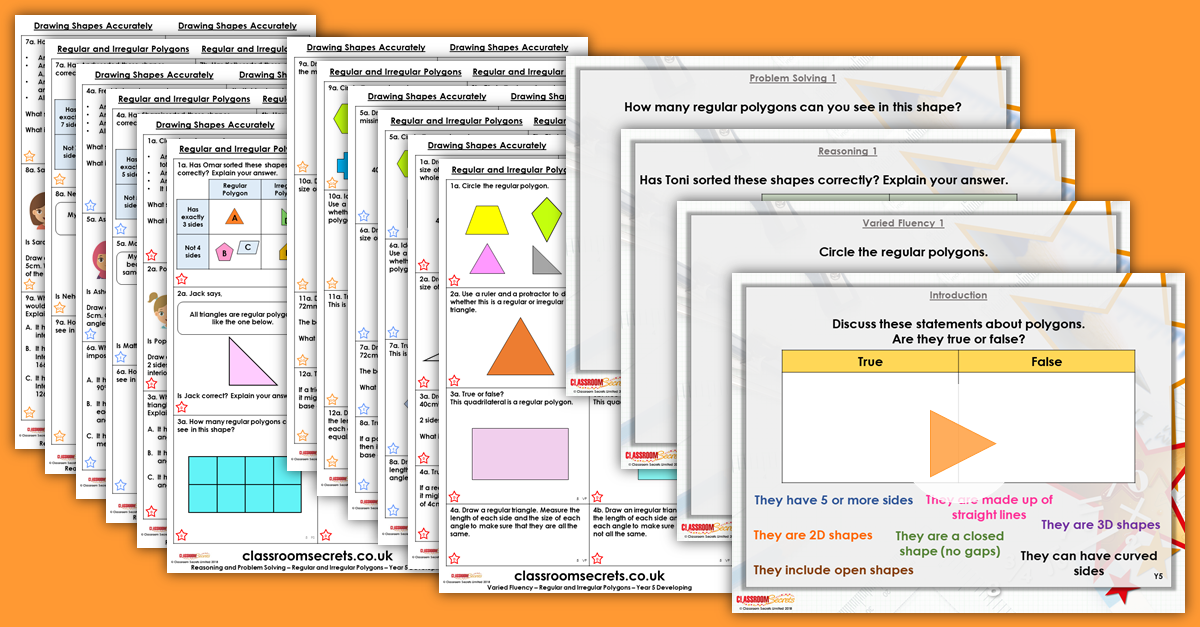Mixed Age Year 5 and 6 Properties of Shape Step 13 Resource Pack

Step 13: Mixed Age Year 5 and 6 Properties of Shape Step 13 Resource Pack
Mixed Age Year 5 and 6 Properties of Shape Step 13 Resource Pack includes a teaching PowerPoint and differentiated varied fluency and reasoning and problem solving resources for this step which covers Year 5 Regular and Irregular Polygons and Year 6 Draw Shapes Accurately for Summer Block 3.
Not a member? Sign up here.
What's included in the Pack?
This Mixed Age Year 5 and 6 Properties of Shape Step 13 pack includes:
- Mixed Age Year 5 and 6 Properties of Shape Step 13 Teaching PowerPoint with examples.
- Year 5 Regular and Irregular Polygons Varied Fluency with answers.
- Year 5 Regular and Irregular Polygons Reasoning and Problem Solving with answers.
- Year 6 Draw Shapes Accurately Varied Fluency with answers.
- Year 6 Draw Shapes Accurately Reasoning and Problem Solving with answers.
National Curriculum Objectives
Mathematics Year 5: (5G2b) Distinguish between regular and irregular polygons based on reasoning about equal sides and angles
Mathematics Year 6: (6G3a) Draw 2-D shapes using given dimensions and angles
Mathematics Year 6: (6G2a) Compare and classify geometric shapes based on their properties and sizes and find unknown angles in any triangles, quadrilaterals, and regular polygons
Differentiation for Year 5 Regular and Irregular Polygons:
Varied Fluency
Developing Questions to support being able to distinguish between regular and irregular polygons. Using regular and irregular triangles and quadrilaterals.
Expected Questions to support being able to distinguish between regular and irregular polygons. Using regular and irregular quadrilaterals, pentagons and hexagons.
Greater Depth Questions to support being able to distinguish between regular and irregular polygons. Includes all polygons up to decagons.
Reasoning and Problem Solving
Questions 1, 4 and 7 (Reasoning)
Developing Explain whether regular and irregular polygons have been sorted correctly. 5 polygons to investigate with 1 or 2 errors to find. Using regular and irregular triangles, quadrilaterals, pentagons and hexagons.
Expected Explain whether regular and irregular polygons have been sorted correctly. 5 or 6 polygons to investigate with 2 or 3 errors to find. Using regular and irregular triangles, quadrilaterals, pentagons, hexagons, octagons and a circle.
Greater Depth Explain whether regular and irregular polygons have been sorted correctly. 7 polygons to investigate with 3 errors to find. Includes all polygons up to decagons and some non-polygon shapes.
Questions 2, 5 and 8 (Reasoning)
Developing Explain whether a child has described a polygon correctly. Using regular and irregular triangles and quadrilaterals.
Expected Explain whether a child has described a polygon correctly. Using regular and irregular pentagons and hexagons.
Greater Depth Explain whether a child has described a polygon correctly. Includes polygons up to decagons.
Questions 3, 6 and 9 (problem Solving)
Developing Investigate how many regular polygons can be found in a shape. Using regular and irregular triangles and quadrilaterals.
Expected Investigate how many regular polygons can be found in a shape. Using regular and irregular triangles, quadrilaterals, pentagons and hexagons.
Greater Depth Investigate how many regular polygons can be found in a shape. Includes all polygons up to decagons.
Differentiation for Year 6 Measure with a Protractor:
Varied Fluency
Developing Questions to support drawing and measuring right-angled triangles, squares and rectangles to the nearest whole cm.
Expected Questions to support drawing and measuring shapes with up to 5 sides to the nearest whole cm or mm.
Greater Depth Questions to support drawing and measuring shapes in cm and mm, including decimals. Shapes with up to 8 sides and compound shapes.
Reasoning and Problem Solving
Questions 1, 4 and 7 (Problem Solving)
Developing Identify shapes and size of angles from given clues. Includes right-angled triangles, squares and rectangles measured to the nearest whole cm.
Expected Identify shapes and size of angles from given clues. Includes shapes with up to 5 sides measured to the nearest whole cm or mm.
Greater Depth Identify shapes and size of angles from given clues. Includes shapes with up to 8 sides and compound shapes measured in cm and mm, including decimals.
Questions 2, 5 and 8 (Reasoning)
Developing Explain whether the individual angles of a shape have been calculated correctly. Includes right-angled triangles, squares and rectangles measured to the nearest whole cm.
Expected Explain whether the individual angles of a shape with up to 5 sides have been calculated correctly. Includes shapes with up to 5 sides measured to the nearest whole cm or mm.
Greater Depth Explain whether the individual angles of a shape with up to 8 sides have been calculated correctly. Includes shapes with up to 8 sides and compound shapes measured in cm and mm, including decimals.
Questions 3, 6 and 9 (Reasoning)
Developing Explain which shape would be impossible to draw. Includes right-angled triangles, squares and rectangles measured to the nearest whole cm. Expected Explain which shape would be impossible to draw. Includes shapes with up to 5 sides measured to the nearest whole cm or mm.
Greater Depth Explain which shape would be impossible to draw. Includes shapes with up to 8 sides and compound shapes measured in cm and mm, including decimals.
This resource is available to download with a Premium subscription.






